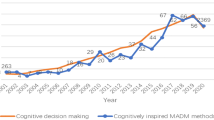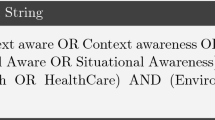Abstract
Real-world applications are characterized by uncertainties, with randomness and fuzziness being the significant challenges inherent in human cognition. The Cloud Model (CM) synthesizes these uncertainties, enabling the transformation between qualitative and quantitative instantiations. Integrating CM with Decision Field Theory (DFT) is essential for managing the complexities of dynamic and probabilistic decision-making. Our research introduces a novel Dynamic Cloud Model based on Decision Field Theory (DCM-DFT). It incorporates an innovative methodology for creating dynamic clouds by capturing initial uncertainty using cloud descriptors. We built a custom time series model to compute attention weights for forecasted periods, effectively managing the full spectrum of uncertainty fluctuations in a decision maker’s dynamic mental state. We demonstrate DCM-DFT’s practical implementation using the Lifestyle and Wellbeing real-time dataset, showcasing fluctuations in decision ranking of alternatives over time. A comparative study exhibits DCM-DFT’s enhanced performance over traditional approaches, significantly improving decision-making preferences in dynamic and uncertain environments.
Access this article
We’re sorry, something doesn't seem to be working properly.
Please try refreshing the page. If that doesn't work, please contact support so we can address the problem.

























Similar content being viewed by others
Data availability
The authors confirm that the data supporting the findings of this study are accessible within the article.
Change history
11 April 2025
“The original online version of this article was revised:” In this article the author’s name Anjali was incorrectly written as Anjali Anjali.
11 April 2025
A Correction to this paper has been published: https://doi.org/10.1007/s11227-025-07286-8
Notes
The cloud Hamming distance \(d(C_a, C_b), a,b \in \mathbb {N}\) satisfies the following key properties:
-
Symmetry: \(d(C_a, C_b) = d(C_b, C_a)\).
-
Law of Indiscernibility: \(d(C_a, C_b) = 0\) if and only if \(C_a = C_b\).
-
Triangle Inequality: \(d(C_a, C_c) \le d(C_a, C_b) + d(C_b, C_c)\) for any clouds \(C_a\), \(C_b\), and \(C_c\).
-
Non-Negativity: \(d(C_a, C_b) \ge 0\) for all \(a\) and \(b\).
-
References
Li D, Du Y (2007) Artificial Intelligence with Uncertainty. Chapman and Hall/CRC 1st edn., London. https://doi.org/10.1201/9781584889991
Wang G, Xu C, Li D (2014) Generic normal cloud model. Inf Sci 280, 1–15 https://doi.org/10.1016/j.ins.2014.04.051
Wang G, Xu C, Zhang Q, Wang X (2012) A multi-step backward cloud generator algorithm. Rough Sets and Current Trends in Computing: 8th International Conference, RSCTC 2012, Chengdu, China, August 17–20, 2012. Proceedings 8. Springer, Berlin, Heidelberg, pp 313–322
Xu C, Wang G, Zhang Q (2014) A new multi-step backward cloud transformation algorithm based on normal cloud model. Fundamenta Informaticae 133(1):55–85. https://doi.org/10.3233/FI-2014-1062
Xu C-L, Wang G-Y (2017) A novel cognitive transformation algorithm based on gaussian cloud model and its application in image segmentation. Numerical Algorithms 76(4):1039–1070. https://doi.org/10.1007/s11075-017-0296-y
Xu C, Wang G (2019) Bidirectional cognitive computing model for uncertain concepts. Cogn. Comput. 11(5):613–629. https://doi.org/10.1007/s12559-019-09666-8
Wang GY, Xu CL, Zhang QH, Wang XR (2013) p-order normal cloud model recursive definition and analysis of bidirectional cognitive computing. Chinese Journal of Computers 36(11):2316–2329. https://doi.org/10.3724/SP.J.1016.2013.02316
Anjali AG (2025) A novel shannon entropy-based backward cloud model and cloud k-means clustering. The Journal of Supercomputing 81(1):65. https://doi.org/10.1007/s11227-024-06528-5
Chauhan P, Gupta A, Malhotra T (2023) A novel cloud model based on multiplicative unbalanced linguistic term set. The Journal of Supercomputing 79:1–31. https://doi.org/10.1007/s11227-023-05295-z
Li DY, Han JW, Shi XM, Man CC (1998) Knowledge representation and discovery based on linguistic atoms. Knowledge-Based Systems 10(7):431–440. https://doi.org/10.1016/S0950-7051(98)00038-0
Wang D, Liu D, Ding H, Singh VP, Wang Y, Zeng X, Wu J, Wang L (2016) A cloud model-based approach for water quality assessment. Environmental Research 148:24–35. https://doi.org/10.1016/j.envres.2016.03.005
Wang D, Zeng D, Singh VP, Xu P, Liu D, Wang Y, Zeng X, Wu J, Wang L (2016) A multidimension cloud model-based approach for water quality assessment. Environmental Research 149:113–121. https://doi.org/10.1016/j.envres.2016.05.012
Song W, Zhu J, Wang H, Chang A (2020) Multistage risk assessment of direct delivery business from local oil refineries in sinopec group based on normal cloud model. International Journal of Production Research 58(18):5624–5650. https://doi.org/10.1080/00207543.2019.1656835
Song W, Zhu J (2019) A multistage risk decision making method for normal cloud model considering behavior characteristics. Applied Soft Computing 78:393–406. https://doi.org/10.1016/j.asoc.2019.02.033
Zhang W, Wu X, Lei Y, Shao J, Wang Z (2023) Risk assessment of water and sand inrush in mining under thick loose layer based on comprehensive weight-cloud model. Geofluids 2023:1–12. https://doi.org/10.1155/2023/1181284
Lin CJ, Zhang M, Li LP, Zhou ZQ, Liu S, Liu C, Li T (2020) Risk assessment of tunnel construction based on improved cloud model. Journal of Performance of Constructed Facilities 34(3):04020028. https://doi.org/10.1061/(ASCE)CF.1943-5509.0001421
Wang J-C, Liu J-Q, Wei Q, Wang P (2021) Risk assessment based on combined weighting-cloud model of tunnel construction. Tehnicki Vjesnik 28(1), 203–210 https://doi.org/10.17559/TV-20200917163330
Xie S, Chen Y, Dong S, Zhang G (2020) Risk assessment of an oil depot using the improved multi-sensor fusion approach based on the cloud model and the belief jensen-shannon divergence. Journal of Loss Prevention in the Process Industries 67:104214. https://doi.org/10.1016/j.jlp.2020.104214
Qin K, Xu K, Liu F, Li D (2011) Image segmentation based on histogram analysis utilizing the cloud model. Computers & Mathematics with Applications 62(7):2824–2833. https://doi.org/10.1016/j.camwa.2011.07.048
Gao Z, Ma D, Guo X, Wang W, Wang Z (2019) The comprehensive assessment method of concrete damage after disastrous fire based on game theory-normal cloud model. Mathematical Problems in Engineering, 1–14 https://doi.org/10.1155/2019/7658426
Wang X, Li S, Xu Z, Hu J, Pan D, Xue Y (2019) Risk assessment of water inrush in karst tunnels excavation based on normal cloud model. Bulletin of Engineering Geology and the Environment 78(5):3783–3798. https://doi.org/10.1007/s10064-018-1294-6
Liu J, Wang D, Lin Q, Deng M (2023) Risk assessment based on fmea combining dea and cloud model: A case application in robot-assisted rehabilitation. Expert Systems with Applications 214:119119. https://doi.org/10.1016/j.eswa.2022.119119
Hwang C-L, Lai Y-J, Liu T-Y (1993) A new approach for multiple objective decision making. Computers & Operations Research 20(8):889–899. https://doi.org/10.1016/0305-0548(93)90109-V
Hwang C-L, Yoon K (2012) Multiple Attribute Decision Making: Methods and Applications - A State-of-the-Art Survey, vol 186. Springer, Berlin
Song Y, Yao H, Yao S, Yu D, Shen Y (2017) Risky multicriteria group decision making based on cloud prospect theory and regret feedback. Mathematical Problems in Engineering 2017(1):9646303. https://doi.org/10.1155/2017/9646303
Berkowitsch N, Scheibehenne B, Rieskamp J (2013) Rigorously testing multialternative decision field theory against random utility models. Journal of Experimental Psychology: General 143(3):1331–1348. https://doi.org/10.1037/a0035159
Cascetta E (2009) Transportation Systems Analysis: Models and Applications vol. 29. Springer, London. https://doi.org/10.1007/978-0-387-75857-2
Zhou J, Liu L-F, Sun L-J, Xiao F (2019) A multi-criteria decision-making method for hesitant fuzzy linguistic term set based on the cloud model and evidence theory. Journal of Intelligent & Fuzzy Systems 36(2):1797–1808. https://doi.org/10.3233/JIFS-18051
Rieskamp J (2008) The probabilistic nature of preferential choice. Journal of Experimental Psychology: Learning, Memory, and Cognition 34(6):1446–1465. https://doi.org/10.1037/a0013646
Busemeyer JR, Townsend JT (1993) Decision field theory: a dynamic-cognitive approach to decision making in an uncertain environment. Psychological review 100(3):432–459
Busemeyer JR, Townsend JT (1992) Fundamental derivations from decision field theory. Mathematical Social Sciences 23(3):255–282
Diederich A (2003) Mdft account of decision making under time pressure. Psychonomic Bulletin & Review 10(1):157–166
Hotaling JM (2020) Decision field theory-planning: A cognitive model of planning on the fly in multistage decision making. Decision 7(1):20–42. https://doi.org/10.1037/dec0000113
Ma R, Liu S, Xu Z, Zhang Y, Ni Y (2024) Research on fuzzy dynamic route choice model and algorithm of wargame. International Journal of Machine Learning and Cybernetics, 1–18 https://doi.org/10.1007/s13042-023-02069-0
Saaty TL (2007) Time dependent decision-making; dynamic priorities in the ahp/anp: Generalizing from points to functions and from real to complex variables. Mathematical and Computer Modelling 46(7–8):860–891
Busemeyer JR, Jessup RK, Johnson JG, Townsend JT (2006) Building bridges between neural models and complex decision making behaviour. Neural Networks 19(8):1047–1058. https://doi.org/10.1016/j.neunet.2006.05.043
Lee S, Son Y-J, Jin J (2008) Decision field theory extensions for behavior modeling in dynamic environment using bayesian belief network. Inf Sci 178(10):2297–2314. https://doi.org/10.1016/j.ins.2008.01.009
Roe RM, Busemeyer JR, Townsend JT (2001) Multialternative decision field theory: A dynamic connectionst model of decision making. Psychological review 108(2):370. https://doi.org/10.1037/0033-295X.108.2.370
Hotaling JM, Busemeyer JR, Li J (2010) Theoretical developments in decision field theory: comment on tsetsos, usher, and chater. 117(4), 1294–1298 https://doi.org/10.1037/a0020401
Qin H, Guan H, Wu Y-J (2013) Analysis of park-and-ride decision behavior based on decision field theory. Transportation Research Part F: Traffic Psychology and Behaviour 18:199–212. https://doi.org/10.1016/j.trf.2013.02.001
Rust J (1994) Structural estimation of markov decision processes. Handbook of Econometrics 4:3081–3143. https://doi.org/10.1016/S1573-4412(05)80020-0
Busemeyer JR, Johnson JG (2004) Computational models of decision making. Blackwell handbook of judgment and decision making, 133–154
Yang Z-l, Huang L-c (2017) Dynamic stochastic multiattribute decision-making that considers stochastic variable variance characteristics under time-sequence contingency environments. Mathematical Problems in Engineering 2017(1), 7126856 https://doi.org/10.1155/2017/7126856
Ho SL, Xie M (1998) The use of arima models for reliability forecasting and analysis. Computers & Industrial Engineering 35(1–2):213–216. https://doi.org/10.1016/S0360-8352(98)00066-7
Jain H, Patel R (2024) Analysis & forecasting of juvenile crime using variance threshold and time series algorithm. Multimedia Tools and Applications, 1–28 https://doi.org/10.1007/s11042-024-19780-x
Dritsakis N, Klazoglou P (2019) Time series analysis using arima models: An approach to forecasting health expenditures in usa. International Economics/Economia Internazionale 72(1):77–106
ArunKumar K, Kalaga DV, Kumar CMS, Chilkoor G, Kawaji M, Brenza TM (2021) Forecasting the dynamics of cumulative covid-19 cases (confirmed, recovered and deaths) for top-16 countries using statistical machine learning models: Auto-regressive integrated moving average (arima) and seasonal auto-regressive integrated moving average (sarima). Applied Soft Computing 103:107161. https://doi.org/10.1016/j.asoc.2021.107161
D, L, Changyu L, Wenyan G (2009) A new cognitive model: Cloud model. International Journal of Intelligent Systems 24(3), 357–375 https://doi.org/10.1002/int.20340
Wang J, Peng L, Zhang H, Chen X (2014) Method of multi criteria group decision making based on cloud aggregation operators with linguistic information. Inf Sci 274:177–191. https://doi.org/10.1016/j.ins.2014.02.130
Wang G, Xu C (2012) Cloud model-a bidirectional cognition model between concept’s extension and intension. In: Hassanien, A.E., Salem, A.-B.M., Ramadan, R., Kim, T. (eds.) Advanced Machine Learning Technologies and Applications. Communications in Computer and Information Science, vol. 274, pp. 391–400. Springer, Berlin, Heidelberg. https://doi.org/10.1007/978-3-642-35326-0_39
Busemeyer JR, Diederich A (2002) Survey of decision field theory. Mathematical Social Sciences 43(3):345–370. https://doi.org/10.1016/S0165-4896(02)00016-1
Hancock TO, Hess S, Choudhury CF (2018) Decision field theory: Improvements to current methodology and comparisons with standard choice modelling techniques. Transportation Research Part B: Methodological 107:18–40
Liu Tao WJ-Q (2012) Uncertain linguistic multi-criteria group decision-making approach based on integrated cloud. Control and Decision 27, 1185–1190
Montgomery D, Runger G (2014) Applied Statistics and Probability for Engineers. John Wiley and Sons, New York, p 765
Brown BB (1968) Delphi process: a methodology used for the elicitation of opinions of experts
Weitendorf D (1976) Beitrag zur optimierung der räumlichen struktur eines gebäudes. PhD thesis, Verlag nicht ermittelbar
Yang X, Yan L, Zeng L (2013) How to handle uncertainties in ahp: The cloud delphi hierarchical analysis. Inf Sci 222:384–404. https://doi.org/10.1016/j.ins.2012.08.019
Funding
The authors indicate that they did not receive any funding from organizations for the submitted work.
Author information
Authors and Affiliations
Contributions
A: conception, methodology, composition, editing and revision; AG: conception, methodology, formal analysis, and review.
Corresponding author
Ethics declarations
Conflict of interest
The authors disclose no competing interests relevant to this article’s content.
Ethical approval
This article does not include any research involving human participants or animals conducted by the authors.
Additional information
Publisher's Note
Springer Nature remains neutral with regard to jurisdictional claims in published maps and institutional affiliations.
“The original online version of this article was revised:” In this article the author’s name Anjali was incorrectly written as Anjali Anjali.
Appendix
Appendix
Table 12 presents the descriptive statistics for each attribute in the Lifestyle and Well-being dataset.
Algorithm 4 outlines the pseudocode for generating dynamic clouds, assessing alternative preferences with dynamic weights from a custom ARIMA model, and calculating the likelihood of selecting one alternative over another.
Rights and permissions
Springer Nature or its licensor (e.g. a society or other partner) holds exclusive rights to this article under a publishing agreement with the author(s) or other rightsholder(s); author self-archiving of the accepted manuscript version of this article is solely governed by the terms of such publishing agreement and applicable law.
About this article
Cite this article
Anjali, Gupta, A. Dynamic cloud model based on decision field theory. J Supercomput 81, 620 (2025). https://doi.org/10.1007/s11227-025-06989-2
Accepted:
Published:
DOI: https://doi.org/10.1007/s11227-025-06989-2





